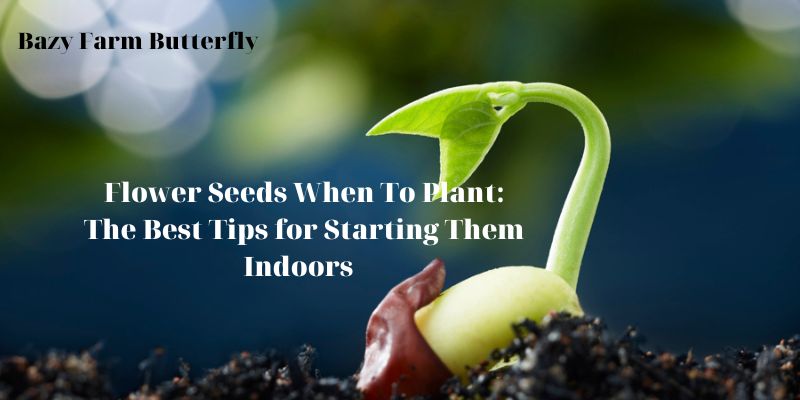If you want to cultivate blossoms, one method to get an early start is to start your seeds indoors. But when should you begin planting your seeds? And what materials do you require to get started? In this piece, Bazy Farm Butterfly’ll discuss how to start flower seeds indoors and address frequently asked concerns about when to plant. This also enables you to regulate the environment and give your seedlings the best start imaginable.
Supplies Needed for Starting Flower Seeds Indoors

To start flower seeds indoors, you’ll need a few key supplies:
Potting Mix
Potting mix is specifically formulated to provide a nutrient-rich atmosphere for your plants to develop in. You can buy it at your local horticulture store or create your own by combining equal parts peat moss, vermiculite, and perlite.
Containers
You can start your seedlings in a variety of receptacles, such as paper cups or waste paper rolls, as well as peat planters or seed-starting trays. Simply make sure they have drainage openings to keep water from accumulating and rotting your seedlings.
Clear Plastic Bags or Lids
Clear plastic bags or covers can be put over your receptacles to create a greenhouse-like atmosphere that will help keep moisture and temperature, encouraging germination.
Watering Can or Spray Bottle
A watering can or spray bottle is needed to keep the soil moist but not waterlogged, which can cause your seedlings to rot.
When to Start Flower Seeds Indoors

When you start your flower seedlings indoors will rely on the sort of bloom you want to cultivate. About flower seeds and when to plant, some flowers can be planted earlier than others, and the scheduling will also be determined by your local environment and the date of the last anticipated frost. Following are some basic guidelines:
Early Starters
Certain flowers, such as daisies, delphinium, and dianthus, should be started 10 to 12 weeks ahead and can be planted out 1 to 2 weeks before the frost-free date.
Mid-Season Starters
Asclepias, foxglove, heliopsis, and phlox take 10 to 12 weeks to grow but need to wait until after the last frost to be transplanted.
Fast-Growing Annuals
Zinnias are fast-growing annuals that can be started indoors or seeded directly in the garden after the last frost.
How to Start Flower Seeds Indoors
Choosing the Right Seeds
It is crucial to choose the right seeds for starting indoors. Most flowers can be begun indoors, but some types perform better than others. Marigolds, petunias, zinnias, and impatiens are some of the simplest flowers to cultivate indoors.
Read the seed packets carefully to determine the best time to start your seeds. Some seeds require longer lead times than others. For example, some seeds need eight weeks of indoor growing before transplanting, while others require only four weeks.
Seed Starting Medium
A good seed starting medium is essential for the successful germination of flower seeds indoors. The seed starting medium should be light, porous, and well-draining.
Fill a seed flat or cell tray with the starting medium, and then firm it into the tray. Ensure that the medium is moist before sowing the seeds.
Planting the Seeds
Sow the seeds according to the package instructions. While some seeds may require light for best germination, others will need to be covered.
Cover the seed flat or cell tray with transparent plastic lids or plastic sheeting once the seeds have been sown to make a small greenhouse. This keeps the earth moist and warm, which is perfect for germination.
Lighting and Temperature
Most seeds require bright, indirect light to germinate successfully. Place the seed flat or cell tray near a south-facing window, or use artificial light if natural light is not available.
Maintain a consistent temperature between 65-75°F (18-24°C) for optimal seed germination.
Watering
Watering is a critical step in seed germination. Keep the seed starting medium moist but not soaking wet. Use a watering can or spray bottle to water the seeds gently.
Transplanting
Once the seeds have germinated and have their first set of true leaves, they are ready to be transplanted into larger containers or outside in the garden.
Tips for Success

- Be patient – some seeds take longer than others to germinate
- Label your seed trays to keep track of which seeds are which
- Keep a consistent temperature and moisture level for optimal seed germination
- Use a fan to improve air circulation and prevent fungal diseases
- Provide adequate light to prevent seedlings from becoming leggy
Starting flower seeds indoors can be a fun and rewarding experience. By following these simple steps, you can ensure your flowers will thrive and provide beautiful blooms for your garden.
Conclusion
Flower seeds when to plant is an excellent method to get an early start on your yard and appreciate gorgeous blooms throughout the season. Whether you start your seeds indoors or outdoors, it’s critical to determine the ideal time to commence, select the appropriate materials, and follow the proper planting and growth procedures. You’ll be well on your way to a lovely flower garden in no time if you follow these guidelines!

